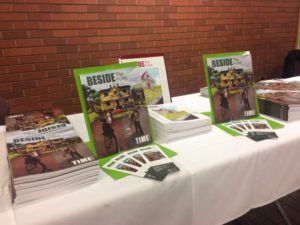For several years, the Creative Writing department at Camosun College was silent, making no publication of its best output. But that’s all changed: Beside the Point is a re-incarnated annual anthology of Camosun students’ writing. Last Wednesday, April 11, we bailed out early from our fiction class to attend the journal’s launch. (Beside the Point is available for purchase at the Camosun bookstores.)
The theme this year is “time.” At the launch, the writers gave readings as enticing samples of their works. Brie Fennell dared to break a rule in her story, “Death is no Longer an Option.” The narrator of a story is never supposed to write “and then I was killed,” but Fennell defied convention, and the story makes even more sense when the reader considers its implications.

Benjamin McFee killed it with the rhythm and rhyme of his poem “The Killing Time.” Katy Weicker (who is also a Nexusstaff writer) comforted us with aching truth in “Hourglass out of Reach.” Nessa Pullman got philosphical and gradually turned up the lights in “The Aha Moment.” In her poem, “Mulan,” Anthea Gaunt painted a nostalgic portrait of the avatar she made of her childhood toy.
How does a kindergartner experience Remembrance Day? Isabella Kennedy showed us how in her poem, “A Minute of Silence.” Some day you may read the sci-fi story, “Time Watch” by Truly Hunter, and you will puzzle over the motivations and dreams of a solitary scientist who may build a time machine that no one else believes in. It works, but will it work again? Will that be an option?
Rachel Smith read the opening pages of her witchcraft story, “Herstory of a Spell,” after which I had to rush home to finish reading the rest.
All the stories and poems presented onstage were impressive. I made a point of going around to each of the authors afterward: asking for an autograph on the page where their piece is printed is an important rite for both of us. Otherwise, these are only printed words on another page. But we are more than printers. We are writers. A cursive signature says: “This writer wrote this note to me. Their other words are printed here for anyone else to read at some future time, but in this present moment, this writer and I conversed.” The writer’s words are a record of a conversation in real time about the virtual conversation that is the written word.
I write to join that virtual conversation. I’d like to get this review of their launch printed in Nexus, and, if that happens, I’ll be just as thrilled if someone comes up to me and asks me to autograph my printed words.
